Re: Big Oil Braced for Global Warming While It Fought Regula
How Exxon went from leader to skeptic on climate change research
By KATIE JENNINGS, DINO GRANDONI AND SUSANNE RUST
OCT. 23, 2015
NOTICE: THIS WORK MAY BE PROTECTED BY COPYRIGHT
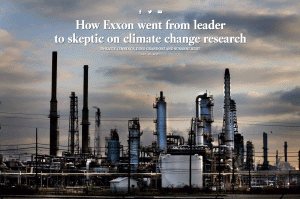
Throughout much of the 1980s, Exxon earned a public reputation as a pioneer in climate change research. It sponsored workshops, funded academic research and conducted its own high-tech experiments exploring the science behind global warming.
But by 1990, the company, in public, took a different posture.
While still funding select research, it poured millions into a campaign that questioned climate change. Over the next 15 years, it took out prominent ads in the Washington Post, the Wall Street Journal and the New York Times, contending climate change science was murky and uncertain. And it argued regulations aimed at curbing global warming were ill-considered and premature.
How did one of the world’s largest oil companies, a leader in climate research, become one of its biggest public skeptics?
The answer, gleaned from a trove of archived company documents and the recollections of former employees, is that Exxon, now known as Exxon Mobil, feared a growing public consensus would lead to financially burdensome policies.
Duane LeVine, Exxon’s manager of science and strategy development, gave a primer to the company’s board of directors in 1989, noting that scientists generally agreed gases released by burning fossil fuels could raise global temperatures significantly by the middle of the 21st century — between 2.7 and 8.1 degrees Fahrenheit — causing glaciers to melt and sea levels to rise, “with generally negative consequences.”
But he also made it clear the company was facing another threat as well — from public policymakers.
“Arguments that we can’t tolerate delay and must act now can lead to irreversible and costly Draconian steps,” LeVine said.
Heat waves and drought had scorched North America in 1988, fueling public concern that the planet was warming. Top government scientists testified in Congress that year, pushing for action.
Lawmakers at home and abroad began calling for reductions in carbon dioxide emissions from fossil fuels — the lifeblood of Exxon’s business. And, in 1988, the United Nations established a panel of scientists to study the issue and make policy recommendations.
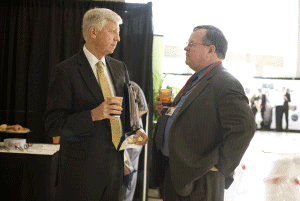
William W. George, left, a director on the Exxon Mobil board, talks with Brian Flannery before the Exxon Mobil annual shareholders meeting in Dallas. (Brian Harkin / Getty Images)
Brian Flannery, Exxon’s longtime in-house climate expert, outlined the threat in a note to his colleagues in an internal company newsletter in 1989.
Government and regulatory efforts to reduce the risk of climate change, Flannery wrote, would “alter profoundly the strategic direction of the energy industry.” And he warned that the impact on the company from those efforts “will come sooner … than from climate change itself.”
The company’s shift — from embracing the science of climate change to publicly questioning it — emerged from interviews with former and current Exxon Mobil employees, and a review of internal company documents by Columbia University’s Energy & Environmental Reporting Project and the Los Angeles Times.
The documents were obtained from the Exxon Mobil Historical Collection at the University of Texas at Austin’s Briscoe Center for American History. (Some of those documents have also been the subject of recent reports by InsideClimate News.)
In a recent interview, Flannery said the company was understandably concerned in the 1980s that government regulations being proposed were simplistic and drastic.
“I followed the climate negotiations, and they’d say things like, ‘We should reduce our emissions of CO2 by 10% by 1990.’ And you’re sitting there, and you say, ‘You guys haven’t a clue’” how difficult and disruptive that would be to global industry and the average consumer, he said.
“This isn’t like making low-fat yogurt,” he said.
In an internal draft memo from August 1988 titled “The Greenhouse Effect,” a company public affairs manager laid out what he called the “Exxon Position.” Toward the end of the document, after an analysis that noted scientific consensus on the role fossil fuels play in global warming, he wrote that the company should “Emphasize the uncertainty.”
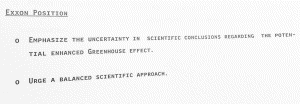
An internal Exxon memo from August 1988 titled “The Greenhouse Effect.”
::
In 1989, Exxon scientists and managers began briefing employees at all levels of the company on the policy implications of climate change.
LeVine made his presentation to the Exxon board as part of that effort, describing the known science and outlining the company’s position.
Other documents in the archives indicate Exxon scientists had been researching the topic for more than a decade — outfitting an oil tanker with carbon dioxide detectors and analyzers and building models to project how a doubling of the gas in the atmosphere would affect global temperatures.
“Data confirm that greenhouse gases are increasing in the atmosphere,” LeVine told the board, according to a copy of his presentation in the Exxon Mobil archive. “Fossil fuels contribute most of the CO2.”
LeVine argued that the growing push by lawmakers to address the problem was “rooted in the evolution of the just-completed Montreal Protocol.”
Two years earlier, the Montreal Protocol, which was signed by the United States and other countries and went intro effect in 1989, had called for phasing out chlorofluorocarbons, or CFCs, a group of chemicals responsible for thinning the ozone layer, which protects Earth from harmful solar radiation.
LeVine pointed out that CFCs had been increasing in the atmosphere, just as carbon dioxide levels were increasing. And just as in the case of greenhouse gases, scientific models predicted that CFCs could have serious future environmental effects.
After years of resistance, chemical companies like DuPont were forced to develop alternatives to CFCs.
CFCs might never have been regulated, LeVine noted, had it not been for one crucial event: the discovery of the ozone hole over Antarctica. That discovery, he said, was just the evidence environmentalists needed to rally the public.
The greenhouse gas issue, LeVine explained, had now reached a similar “critical event”: the hot and dry summer of 1988, which caused one of the worst droughts in U.S. history.

Walking through his drought-damaged cornfield in Gilbertville, Iowa, in June 1988, Firmin Rottinghauf, 72, calls the conditions “the worst I've seen since ’36.” (John Gaps III / Associated Press)
At the time, a growing number of experts were “talking about what climate change could mean in the near-term and long-term future,” recalled Joseph Carlson, a now-retired public affairs manager for Exxon who helped draft the company’s position.
That summer, James Hansen, then a NASA climate scientist, told Congress global warming had already begun. His testimony, enhanced by the sweltering temperatures outside, prompted many Americans to begin taking the threat of a hotter planet seriously. Time magazine even put the Earth on its cover as “Planet of the Year.”

Jim Hansen, background, works with student Josh Wilder at NASA’s Goddard Institute of Space Studies in New York in 1997. (Jim Cooper / Associated Press)
Climate scientists, then and now, note that isolated heat waves and droughts are not necessarily the direct result of planetary warming. But, coming in the midst of that debate, that heat wave, which caused more than 5,000 deaths in the United States and cost nearly $40 billion, had a big impact.
So LeVine laid out a plan for the “Exxon Position”: In order to stop the momentum behind the issue, LeVine said Exxon should emphasize that doubt. Tell the public that more science is needed before regulatory action is taken, he argued, and emphasize the “costs and economics” of restricting carbon dioxide emissions.
Banning CFCs “pales by comparison to the difficulties of applying similar approaches” to carbon dioxide, an unavoidable byproduct of burning fossil fuels, which produce most of the world’s electricity, he said.
The company recently declined to comment on the 1989 board meeting. LeVine declined to comment for this story as well. Of the six living members of that board of directors, one declined to comment and five could not be reached.
Alan Jeffers, an Exxon Mobil spokesman, said: “Exxon Mobil has always advocated for good public policy that is based on sound science” and the archived documents reflect “a balanced approach to communicating the risk of climate change.” And he provided a list of more than 50 peer-reviewed publications showing the company continued investigating climate change science throughout the 1990s and 2000s.
::
By the early 1990s, Exxon began putting its new public relations strategy into practice.
At the company’s annual shareholders’ meeting in 1990, the board of directors denounced a dissident shareholder proposal that called for Exxon to reduce carbon dioxide emissions, citing “great scientific uncertainties” about the environmental effects of global climate change. The board also criticized “drastic and precipitant proposals,” like those being considered by the United Nations.
In 1992, Exxon joined the Global Climate Coalition, an association of companies from industries linked to fossil fuels, which vigorously fought potential climate change regulations by emphasizing scientific uncertainty and underscoring the negative economic impact of such laws on consumers.
From 1998 to 2005, Exxon contributed almost $16 million to at least 43 organizations to wage a campaign raising questions about climate change, according to the Union of Concerned Scientists, an environmental activist group. Greenpeace has estimated that Exxon spent more than $30 million in that effort.
Exxon’s executives also publicly questioned climate change science.
In 1997, Exxon’s chairman and chief executive, Lee Raymond, derided potential regulations on carbon emissions at a meeting of the World Petroleum Council in Beijing.
“Many people — politicians and the public alike — believe that global warming is a rock-solid certainty,” Raymond said. “But it's not.”
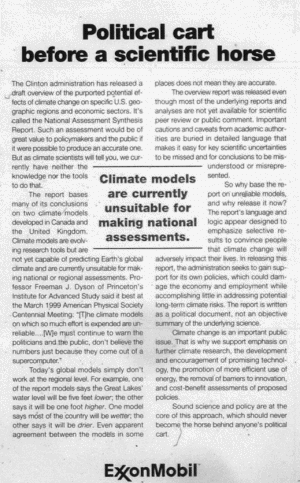
An Exxon Mobil ad from the Washington Post in 2000.
In the U.S., Exxon took out newspaper ads disparaging federal research into the effect of climate change on different areas of the U.S.
“Today’s global models simply don’t work at a regional level,” read an Exxon Mobil ad in an August 2000 edition of the Washington Post. It went on: “That is why we support emphasis on further climate research.”
::
In 1997, the U.S. Senate refused to ratify a U.N. treaty committing states to reduce greenhouse gases because restrictions on carbon dioxide emissions “could result in serious harm to the United States economy” — an argument Exxon used repeatedly in its public-relations campaign.
Today, the effect of climate change is widely accepted. Average global temperatures have risen approximately 1.5 degrees since 1880, and the sea level has risen at a rate of 0.06 of an inch per year and is accelerating. Moreover, Arctic sea ice coverage is shrinking so drastically that last August, National Geographic had to redraw its atlas maps.
In 2007, the company, for the first time since the early 1980s, publicly conceded that climate change was occurring and that it was in large part the result of the burning of fossil fuels.
“There was a fork in the road. They had the opportunity to make a decision to go one way or the other way,” said Martin Hoffert, an Exxon consultant in the 1980s and professor emeritus of physics at New York University. “If Exxon had listened to its scientists and endorsed our research — and not started that campaign — it would have had, in my opinion, an enormous impact.”
Amy Lieberman, Sara Jerving and Masako Melissa Hirsch contributed to this report.
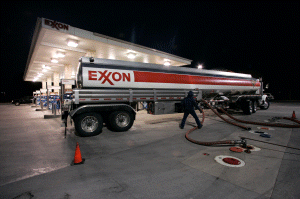
A gasoline tanker delivers fuel to an Exxon station in Keller, Texas, in 2007. (Donna McWilliam / Associated Press)
Contact the reporters
About this story:
Over the last year, the Energy and Environmental Reporting Project at Columbia University’s Graduate School of Journalism, with the Los Angeles Times, has been researching the gap between Exxon Mobil’s public position and its internal planning on the issue of climate change. As part of that effort, reporters reviewed hundreds of documents housed in archives in Calgary’s Glenbow Museum and at the University of Texas. They also reviewed scientific journals and interviewed dozens of experts, including former Exxon Mobil employees. This is the second in a series of occasional articles.
The Energy and Environmental Reporting Project is supported by the Energy Foundation, Open Society Foundations, Rockefeller Brothers Fund, Rockefeller Family Fund, Lorana Sullivan Foundation and the Tellus Mater Foundation. The funders have no involvement in or influence over the articles produced by project fellows in collaboration with The Times.
Additional credits: Digital producer: Evan Wagstaff. Lead photo caption: The Baytown Exxon gas refinery, seen in 2006, produced more processed oil than any other facility in the United States. (Benjamin Lowy / Getty Images)
By KATIE JENNINGS, DINO GRANDONI AND SUSANNE RUST
OCT. 23, 2015
NOTICE: THIS WORK MAY BE PROTECTED BY COPYRIGHT
YOU ARE REQUIRED TO READ THE COPYRIGHT NOTICE AT THIS LINK BEFORE YOU READ THE FOLLOWING WORK, THAT IS AVAILABLE SOLELY FOR PRIVATE STUDY, SCHOLARSHIP OR RESEARCH PURSUANT TO 17 U.S.C. SECTION 107 AND 108. IN THE EVENT THAT THE LIBRARY DETERMINES THAT UNLAWFUL COPYING OF THIS WORK HAS OCCURRED, THE LIBRARY HAS THE RIGHT TO BLOCK THE I.P. ADDRESS AT WHICH THE UNLAWFUL COPYING APPEARED TO HAVE OCCURRED. THANK YOU FOR RESPECTING THE RIGHTS OF COPYRIGHT OWNERS.

Throughout much of the 1980s, Exxon earned a public reputation as a pioneer in climate change research. It sponsored workshops, funded academic research and conducted its own high-tech experiments exploring the science behind global warming.
But by 1990, the company, in public, took a different posture.
While still funding select research, it poured millions into a campaign that questioned climate change. Over the next 15 years, it took out prominent ads in the Washington Post, the Wall Street Journal and the New York Times, contending climate change science was murky and uncertain. And it argued regulations aimed at curbing global warming were ill-considered and premature.
How did one of the world’s largest oil companies, a leader in climate research, become one of its biggest public skeptics?
The answer, gleaned from a trove of archived company documents and the recollections of former employees, is that Exxon, now known as Exxon Mobil, feared a growing public consensus would lead to financially burdensome policies.
Duane LeVine, Exxon’s manager of science and strategy development, gave a primer to the company’s board of directors in 1989, noting that scientists generally agreed gases released by burning fossil fuels could raise global temperatures significantly by the middle of the 21st century — between 2.7 and 8.1 degrees Fahrenheit — causing glaciers to melt and sea levels to rise, “with generally negative consequences.”
But he also made it clear the company was facing another threat as well — from public policymakers.
“Arguments that we can’t tolerate delay and must act now can lead to irreversible and costly Draconian steps,” LeVine said.
Heat waves and drought had scorched North America in 1988, fueling public concern that the planet was warming. Top government scientists testified in Congress that year, pushing for action.
Lawmakers at home and abroad began calling for reductions in carbon dioxide emissions from fossil fuels — the lifeblood of Exxon’s business. And, in 1988, the United Nations established a panel of scientists to study the issue and make policy recommendations.

William W. George, left, a director on the Exxon Mobil board, talks with Brian Flannery before the Exxon Mobil annual shareholders meeting in Dallas. (Brian Harkin / Getty Images)
Brian Flannery, Exxon’s longtime in-house climate expert, outlined the threat in a note to his colleagues in an internal company newsletter in 1989.
Government and regulatory efforts to reduce the risk of climate change, Flannery wrote, would “alter profoundly the strategic direction of the energy industry.” And he warned that the impact on the company from those efforts “will come sooner … than from climate change itself.”
The company’s shift — from embracing the science of climate change to publicly questioning it — emerged from interviews with former and current Exxon Mobil employees, and a review of internal company documents by Columbia University’s Energy & Environmental Reporting Project and the Los Angeles Times.
The documents were obtained from the Exxon Mobil Historical Collection at the University of Texas at Austin’s Briscoe Center for American History. (Some of those documents have also been the subject of recent reports by InsideClimate News.)
In a recent interview, Flannery said the company was understandably concerned in the 1980s that government regulations being proposed were simplistic and drastic.
“I followed the climate negotiations, and they’d say things like, ‘We should reduce our emissions of CO2 by 10% by 1990.’ And you’re sitting there, and you say, ‘You guys haven’t a clue’” how difficult and disruptive that would be to global industry and the average consumer, he said.
“This isn’t like making low-fat yogurt,” he said.
In an internal draft memo from August 1988 titled “The Greenhouse Effect,” a company public affairs manager laid out what he called the “Exxon Position.” Toward the end of the document, after an analysis that noted scientific consensus on the role fossil fuels play in global warming, he wrote that the company should “Emphasize the uncertainty.”

An internal Exxon memo from August 1988 titled “The Greenhouse Effect.”
EXXON POSITION: EMPHASIZE THE UNCERTAINTY IN SCIENTIFIC CONCLUSIONS REGARDING THE POTENTIAL ENHANCED GREENHOUSE EFFECT; URGE A BALANCED SCIENTIFIC APPROACH
::
In 1989, Exxon scientists and managers began briefing employees at all levels of the company on the policy implications of climate change.
LeVine made his presentation to the Exxon board as part of that effort, describing the known science and outlining the company’s position.
Other documents in the archives indicate Exxon scientists had been researching the topic for more than a decade — outfitting an oil tanker with carbon dioxide detectors and analyzers and building models to project how a doubling of the gas in the atmosphere would affect global temperatures.
“Data confirm that greenhouse gases are increasing in the atmosphere,” LeVine told the board, according to a copy of his presentation in the Exxon Mobil archive. “Fossil fuels contribute most of the CO2.”
LeVine argued that the growing push by lawmakers to address the problem was “rooted in the evolution of the just-completed Montreal Protocol.”
Two years earlier, the Montreal Protocol, which was signed by the United States and other countries and went intro effect in 1989, had called for phasing out chlorofluorocarbons, or CFCs, a group of chemicals responsible for thinning the ozone layer, which protects Earth from harmful solar radiation.
LeVine pointed out that CFCs had been increasing in the atmosphere, just as carbon dioxide levels were increasing. And just as in the case of greenhouse gases, scientific models predicted that CFCs could have serious future environmental effects.
After years of resistance, chemical companies like DuPont were forced to develop alternatives to CFCs.
CFCs might never have been regulated, LeVine noted, had it not been for one crucial event: the discovery of the ozone hole over Antarctica. That discovery, he said, was just the evidence environmentalists needed to rally the public.
The greenhouse gas issue, LeVine explained, had now reached a similar “critical event”: the hot and dry summer of 1988, which caused one of the worst droughts in U.S. history.

Walking through his drought-damaged cornfield in Gilbertville, Iowa, in June 1988, Firmin Rottinghauf, 72, calls the conditions “the worst I've seen since ’36.” (John Gaps III / Associated Press)
At the time, a growing number of experts were “talking about what climate change could mean in the near-term and long-term future,” recalled Joseph Carlson, a now-retired public affairs manager for Exxon who helped draft the company’s position.
That summer, James Hansen, then a NASA climate scientist, told Congress global warming had already begun. His testimony, enhanced by the sweltering temperatures outside, prompted many Americans to begin taking the threat of a hotter planet seriously. Time magazine even put the Earth on its cover as “Planet of the Year.”

Jim Hansen, background, works with student Josh Wilder at NASA’s Goddard Institute of Space Studies in New York in 1997. (Jim Cooper / Associated Press)
Climate scientists, then and now, note that isolated heat waves and droughts are not necessarily the direct result of planetary warming. But, coming in the midst of that debate, that heat wave, which caused more than 5,000 deaths in the United States and cost nearly $40 billion, had a big impact.
So LeVine laid out a plan for the “Exxon Position”: In order to stop the momentum behind the issue, LeVine said Exxon should emphasize that doubt. Tell the public that more science is needed before regulatory action is taken, he argued, and emphasize the “costs and economics” of restricting carbon dioxide emissions.
Banning CFCs “pales by comparison to the difficulties of applying similar approaches” to carbon dioxide, an unavoidable byproduct of burning fossil fuels, which produce most of the world’s electricity, he said.
The company recently declined to comment on the 1989 board meeting. LeVine declined to comment for this story as well. Of the six living members of that board of directors, one declined to comment and five could not be reached.
Alan Jeffers, an Exxon Mobil spokesman, said: “Exxon Mobil has always advocated for good public policy that is based on sound science” and the archived documents reflect “a balanced approach to communicating the risk of climate change.” And he provided a list of more than 50 peer-reviewed publications showing the company continued investigating climate change science throughout the 1990s and 2000s.
::
By the early 1990s, Exxon began putting its new public relations strategy into practice.
At the company’s annual shareholders’ meeting in 1990, the board of directors denounced a dissident shareholder proposal that called for Exxon to reduce carbon dioxide emissions, citing “great scientific uncertainties” about the environmental effects of global climate change. The board also criticized “drastic and precipitant proposals,” like those being considered by the United Nations.
In 1992, Exxon joined the Global Climate Coalition, an association of companies from industries linked to fossil fuels, which vigorously fought potential climate change regulations by emphasizing scientific uncertainty and underscoring the negative economic impact of such laws on consumers.
From 1998 to 2005, Exxon contributed almost $16 million to at least 43 organizations to wage a campaign raising questions about climate change, according to the Union of Concerned Scientists, an environmental activist group. Greenpeace has estimated that Exxon spent more than $30 million in that effort.
Exxon’s executives also publicly questioned climate change science.
In 1997, Exxon’s chairman and chief executive, Lee Raymond, derided potential regulations on carbon emissions at a meeting of the World Petroleum Council in Beijing.
“Many people — politicians and the public alike — believe that global warming is a rock-solid certainty,” Raymond said. “But it's not.”

An Exxon Mobil ad from the Washington Post in 2000.
Political cart before a scientific horse
by Exxon Mobil Corporation
© 2000 Exxon Mobil Corporation
The Clinton administration has released a draft overview of the purported potential effects of climate change on specific U.S. geographic regions and economic sectors. It's called the National Assessment Synthesis Report. Such an assessment would be of great value to policymakers and the public if it were possible to produce an accurate one. But as climate scientists will tell you, we currently have neither the knowledge nor the tools to do that.
The report bases many of its conclusions on two climate models developed in Canada and the United Kingdom. Climate models are evolving research tools but are not yet capable of predicting Earth's global climate and are currently unsuitable for making national or regional assessments. Professor Freeman J. Dyson of Princeton's Institute for Advanced Study said it best at the March 1999 American Physical Society Centennial Meeting: "[T]he climate models on which so much effort is expended are unreliable ... [W]e must continue to warn the politicians and the public, don't believe the numbers just because they come out of a supercomputer."
Today's global models simply don't work at the regional level. For example, one of the report models says the Great Lakes' water level will be five feet lower; the other says it will be one foot higher. One model says most of the country will be wetter; the other says it will be drier. Even apparent agreement between the models in some places does not mean they are accurate.
The overview report was released even though most of the underlying reports and analyses are not yet available for scientific peer review or public comment. Important cautions and caveats from academic authorities are buried in detailed language that makes it easy for key scientific uncertainties to be missed and for conclusions to be misunderstood or misrepresented.
So why base the report on unreliable models, and why release it now? The report's language and logic appear designed to emphasize selective results to convince people that climate change will adversely impact their lives. In releasing this report, the administration seeks to gain support for its own policies, which could damage the economy and employment while accomplishing little in addressing potential long-term climate risks. The report is written as a political document, not an objective summary of the underlying science.
Climate change is an important public issue. That is why we support emphasis on further climate research, the development and encouragement of promising technology, the promotion of more efficient use of energy, the removal of barriers to innovation, and cost-benefit assessments of proposed policies.
Sound science and policy are at the core of this approach, which should never become the horse behind anyone's political cart.
ExxonMobil
In the U.S., Exxon took out newspaper ads disparaging federal research into the effect of climate change on different areas of the U.S.
“Today’s global models simply don’t work at a regional level,” read an Exxon Mobil ad in an August 2000 edition of the Washington Post. It went on: “That is why we support emphasis on further climate research.”
::
In 1997, the U.S. Senate refused to ratify a U.N. treaty committing states to reduce greenhouse gases because restrictions on carbon dioxide emissions “could result in serious harm to the United States economy” — an argument Exxon used repeatedly in its public-relations campaign.
Today, the effect of climate change is widely accepted. Average global temperatures have risen approximately 1.5 degrees since 1880, and the sea level has risen at a rate of 0.06 of an inch per year and is accelerating. Moreover, Arctic sea ice coverage is shrinking so drastically that last August, National Geographic had to redraw its atlas maps.
In 2007, the company, for the first time since the early 1980s, publicly conceded that climate change was occurring and that it was in large part the result of the burning of fossil fuels.
“There was a fork in the road. They had the opportunity to make a decision to go one way or the other way,” said Martin Hoffert, an Exxon consultant in the 1980s and professor emeritus of physics at New York University. “If Exxon had listened to its scientists and endorsed our research — and not started that campaign — it would have had, in my opinion, an enormous impact.”
Amy Lieberman, Sara Jerving and Masako Melissa Hirsch contributed to this report.

A gasoline tanker delivers fuel to an Exxon station in Keller, Texas, in 2007. (Donna McWilliam / Associated Press)
Contact the reporters
About this story:
Over the last year, the Energy and Environmental Reporting Project at Columbia University’s Graduate School of Journalism, with the Los Angeles Times, has been researching the gap between Exxon Mobil’s public position and its internal planning on the issue of climate change. As part of that effort, reporters reviewed hundreds of documents housed in archives in Calgary’s Glenbow Museum and at the University of Texas. They also reviewed scientific journals and interviewed dozens of experts, including former Exxon Mobil employees. This is the second in a series of occasional articles.
The Energy and Environmental Reporting Project is supported by the Energy Foundation, Open Society Foundations, Rockefeller Brothers Fund, Rockefeller Family Fund, Lorana Sullivan Foundation and the Tellus Mater Foundation. The funders have no involvement in or influence over the articles produced by project fellows in collaboration with The Times.
Additional credits: Digital producer: Evan Wagstaff. Lead photo caption: The Baytown Exxon gas refinery, seen in 2006, produced more processed oil than any other facility in the United States. (Benjamin Lowy / Getty Images)